Through its subsidiary Carbon TerraVault, California Resources Corporation will approach carbon capture and blue molecule production investments on a project-level basis to help meet California’s lofty decarbonization goals, Chief Sustainability Officer Chris Gould said in an interview.
Carbon TerraVault is differentiated by its nature as a CCS-as-a-service company, Gould said, as most CCS projects are owned by emitters themselves.
“We are bringing to market a solution to decarbonize other parts of the California economy,” Gould said, noting that hydrogen producers, power plants and steel and cement makers are among potential clients. “We are out across the state, working with emitters.”
Carbon TerraVault is self-mandated to return one billion tons of carbon back into the ground, first as a gas and then pressurized into liquid. Revenue comes from the federal 45Q incentive and the California LCFS and related tradeable market.
The company has a JV with Brookfield Renewable for the first 200 million tons. That JV recently formed a separate JV with Lone Cypress Energy Services for a planned blue hydrogen plant at the Elk Hills Field in Kern County.
Carbon TerraVault will provide permanent sequestration for 100,000 MTPA at the facility, and will receive an injection fee on a per ton basis, according to a December 7 presentation.
In hiring Carbon TerraVault to provide CCS as a service, LoneCypress also invited the company to invest in the production, Gould said. The JV has the right to participate in the blue hydrogen facility up to and including a majority equity stake, the presentation shows.
“You should expect to see over time as we do more and more of these that we’re going to have multiple models,” Gould said of these partnerships and financial structures. A typical model may emerge as the industry matures.
The company could repeat that effort for “many more” blue hydrogen projects in the state, Gould said. “Green [hydrogen] is a longer-term proposition that is going to be based on renewable buildout,” he said. “Blue is kind of here now.”
Target market
Carbon TerraVault estimates that California’s total CCS market opportunity is between 150 MMTPA – 210 MMTPA, and is in discussions for 8 MMTPA of CCS, of which 1 MMTPA is in advanced discussions, the presentation shows.
Through California Resources’ Elk Hills land position of 47,000 acres and CO2 sequestration reservoirs, the company could attract additional greenfield infrastructure projects like the Lone Cypress Hydrogen Project and create a Net Zero Industrial Park, according to the presentation.
In that vein, Gould noted the huge need for decarbonized ammonia in California’s central valley agriculture, which today is imported from abroad.
“There is a need for clean hydrogen in California and it is best if it is created in California,” Gould said.
The JV with Brookfield funds Carbon TerraVault’s storage needs, Gould said. Investments in the production processes, such as the deal with Lone Cypress, will likely require additional capital.
Project level financing is a “default assumption,” Gould said, though that’s not set in stone. The company is working with a financial advisor but Gould declined to name the firm.
The scale of California’s hydrogen ambitions is far beyond what any one company can do, Gould said.
“If you’re an advisor that is working with a developer likeLone Cypress that is considering locating in California, then I would say give us a ring,” Gould said. “We’re the ones who are going to be able to do the sequestration there.”







